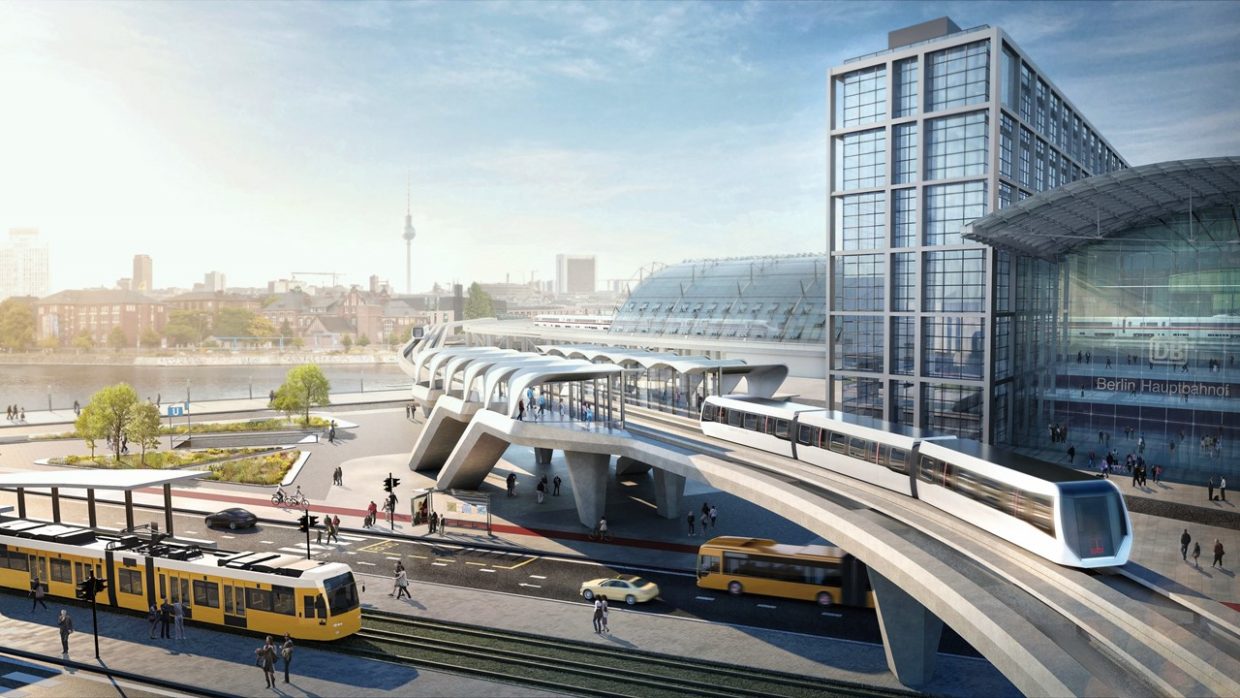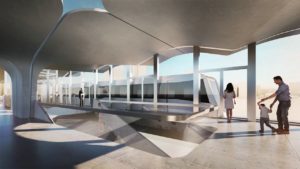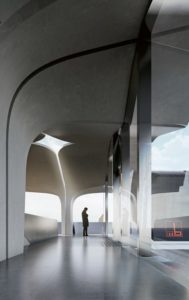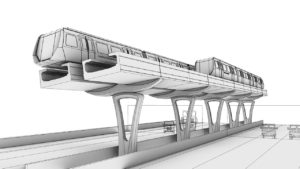ENGLISH VERSION: BELOW
Auch zum Abschluss der Woche beschäftigen wir uns mit einem weiteren Infrastrukturthema. Während die bisher behandelten Themen – mögliche Verlängerung von Berlins U-Bahn-Strecken oder die Ausschreibung des S-Bahnbetriebs ab 2027 – ganz konkrete Projektvorhaben sind, ist das heutige Thema eher ein visionärer Blick in eine mögliche Zukunft des autofreien Nah- und Fernverkehrs.
Max Bögl Gruppe: Vorschlag für Magnetschwebebahn
Im Auftrag der Firmengruppe Max Bögl hat das Berliner Architekturbüro “Graft”, über dessen “Eiswerk”-Projekt wir erst kürzlich berichteten, die Visualisierung einer Magnetschwebebahn in einem urbanen Kontext vorgenommen und sich das derzeit durch Baustellen geprägte Umfeld des Berliner Hauptbahnhofs ausgesucht.
Das Unternehmen Max Bögl ist mit 6.500 Mitarbeiter*innen an weltweit 40 Standorten und einem Jahresumsatz von über zwei Milliarden Euro eines der größten Bauunternehmen der deutschen Bauindustrie. Das Unternehmen konzipiert und produziert Eigenentwicklungen zu Themen wie erneuerbare Energien, Urbanisierung, Mobilität und Infrastruktur.
“Graft” visualisiert ein mögliches, urbanes Magnet-Transportsystem
Eine der spannendsten Entwicklungen ist nun die von “Graft” visualisierte, marktreife Magnetschwebebahn mit dem Namen “Transport System Bögl (TSB)”.
Zur Visualisierung gehörte die Entwicklung von Strecken und Stationen für das “intelligent gesteuerte, fahrerlose Bahnsystem, das zu einem lärm- und emissionsarmen Verkehr” in der Zukunft beitragen soll. Dabei ging es nicht nur um die Gestaltung der Strecken selbst, sondern auch um deren Anpassungsfähigkeit an bereits bestehende Verkehrsknotenpunkte.
Fahrerloses, emissionsarmes System
Die Logik des TSB-Systems aufgreifend, das mit einem hohen Anteil an vorgefertigten Elementen seriell produziert werden soll, sieht der Entwurf von “Graft” ein modulares System vor, welches vorgefertigte Bauteile verwendet, die abhängig von den Anforderungen an die verschiedenen Stationstypen eingesetzt werden können.
Neben den Entwürfen für die Magnetschwebebahn sowie deren Stationen schlägt das Büro “Graft” zudem einen fiktiven, aber realisierbaren Magnetschwebebahn-Streckenplan für Berlin vor. Dieser verbindet Standorte, die ein großes Potenzial für die Entwicklung der Stadt erschließen würden, wie etwa den Hauptbahnhof, den Charité Campus Mitte, den Charité Campus Virchow Klinikum und die neue “TXL Urban Tech Republic“.
Fiktiver Streckenplan für Berlin
Mit den Stationen Charité Campus Mitte und Charité Campus Virchow Klinikum könnten sogar zwei zentrale Krankenhaus-Standorte zu einem gemeinsamen Campus verbunden werden, zwischen denen sich Patienten, Mitarbeiter, Forscher und Materialien schnell und einfach bewegen können.
Nachdem das Thema Magnetschwebebahn nicht nur in Berlin eine lange Geschichte nicht umgesetzter Ideen beinhaltet, ist dieser neuerliche Vorstoß der Max Bögl Gruppe und des Büros “Graft” sicher eine Diskussion wert, denn die wachsende Hauptstadt braucht innovative und zukunftsträchtige Ideen, um den wachsenden Anforderungen an emissionsfreie Verkehrsmittel gerecht zu werden.
Weitere Projekte des Architekturbüros “Graft” findet Ihr hier.
© Grafiken: GRAFT Gesellschaft von Architekten mbH
Also at the end of the week, we deal with another infrastructure topic. While the topics covered so far – possible extensions of Berlin’s subway lines or the bidding process for S-Bahn operations from 2027 – are quite concrete project plans, today’s topic is more of a visionary look into a possible future of car-free local and long-distance transportation.
MAX BÖGL GROUP: PROPOSAL FOR MAGNETIC LEVITATION TRAIN
On behalf of the Max Bögl Group, the Berlin-based architectural firm “Graft”, whose “Eiswerk” project we reported on recently, has undertaken the visualization of a maglev train in an urban context and has chosen the surroundings of Berlin’s main train station, which are currently characterized by construction sites.
With 6,500 employees at 40 locations worldwide and annual sales of over two billion euros, Max Bögl is one of the largest construction companies in the German construction industry. The company designs and produces its own developments on topics such as renewable energies, urbanization, mobility and infrastructure.
“GRAFT” VISUALIZES A POSSIBLE URBAN MAGNET TRANSPORT SYSTEM
One of the most exciting developments now is the market-ready magnetic levitation train called “Transport System Bögl (TSB)” visualized by “Graft”.
The visualization included the development of routes and stations for the “intelligently controlled, driverless rail system that will contribute to low-noise, low-emission transportation” in the future. The focus was not only on the design of the routes themselves, but also on their adaptability to existing transport hubs.
DRIVERLESS, LOW-EMISSION SYSTEM
Picking up on the logic of the TSB system, which is intended to be mass-produced with a high proportion of prefabricated elements, the design of “Graft” envisages a modular system that uses prefabricated components that can be used depending on the requirements for the different types of stations.
In addition to the designs for the maglev train as well as its stations, the “Graft” office also proposes a fictitious but feasible maglev route plan for Berlin. This connects locations that would open up great potential for the development of the city, such as the main train station, the Charité Campus Mitte, the Charité Campus Virchow Klinikum and the new “TXL Urban Tech Republic“.
FICTITIOUS ROUTE PLAN FOR BERLIN
With the Charité Campus Mitte and Charité Campus Virchow Klinikum stations, two central hospital locations could even be connected to form a joint campus, between which patients, employees, researchers and materials could move quickly and easily.
Since the topic of magnetic levitation trains has a long history of unimplemented ideas, not only in Berlin, this latest venture by the Max Bögl Group and the “Graft” office is certainly worth discussing, because the growing capital city needs innovative and forward-looking ideas to meet the growing demands for emission-free transportation.






3 Pingbacks